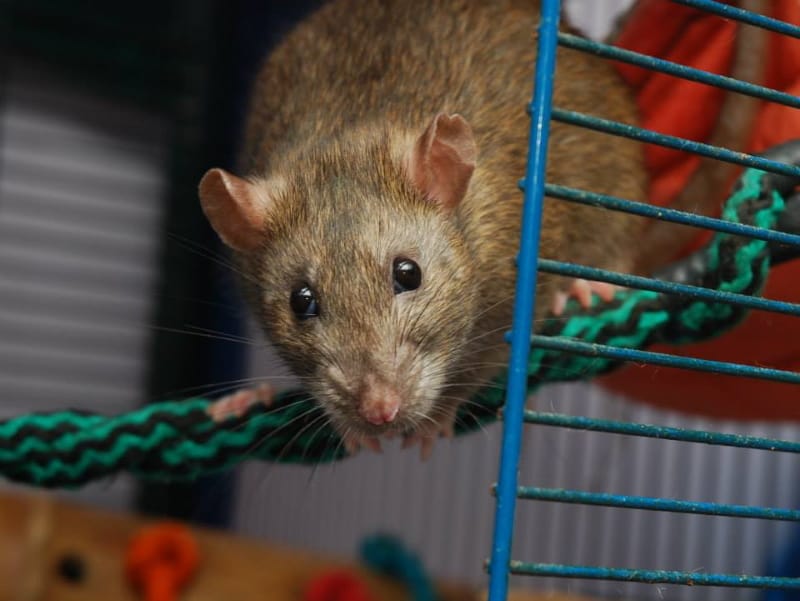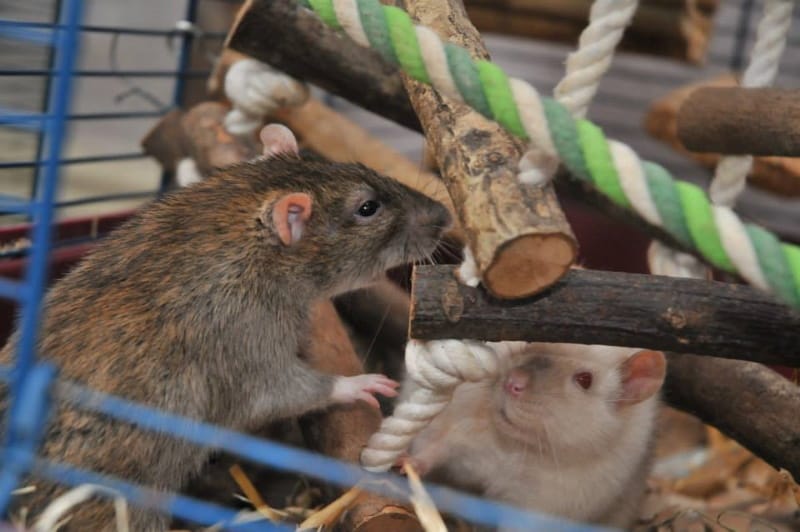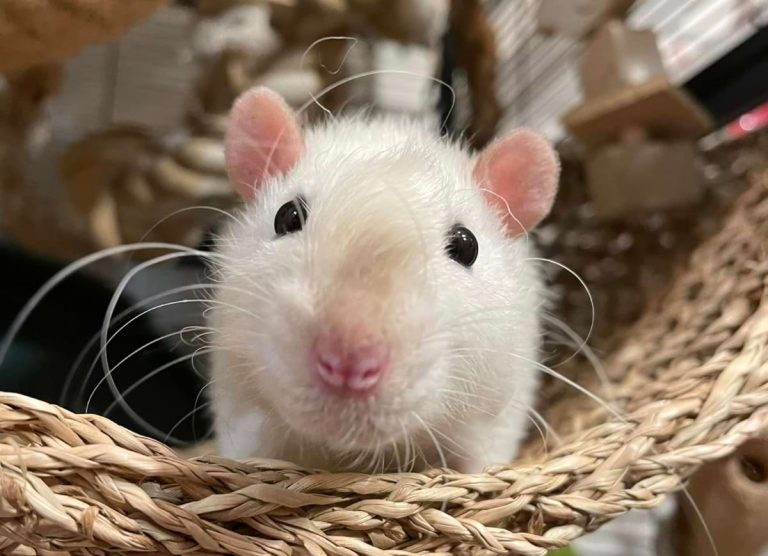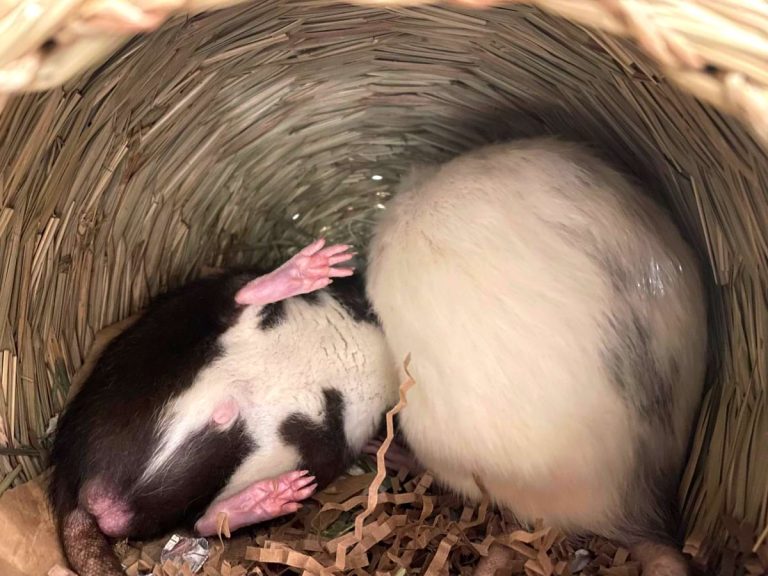How Long Do Pet Rats Live? Pet Rat Lifespan & How to Help Extend a Rat’s Life

Rats make fantastic pets for all sorts of reasons – not least that they are adorable, smart, and love interacting with people. However, there is one potential downside that puts some owners off – while rats have massive personalities to fall in love with, they don’t live very long compared to animals like dogs or cats.
All sorts of claims are made on the internet about pet rat lifespan – I’ve seen everything from 12 months to 7 years (neither of which is normal). What sort of lifespan should you actually expect for your pet rats? Let’s look at some data.
Average Pet Rat Lifespans 2010-2016
Fortunately, we have a great resource on the internet to help answer the question. The Ratty Corner website ran a survey from 2010-2016 collecting data on how long rats live for in different parts of the world.
Looking at data for 584 rats, Ratty Corner found that the average lifespan was 25.6 months, i.e. just over 2 years. When the data was broken down into countries:
- the UK had a pet rat lifespan of 25.2 months,
- the USA of 27.3 months,
- and Australia of 24.8 months.
- European countries with more than 10 rats recorded sat in the same lifespan range.
Is this data trustworthy? I think so. Although it is self-reported (i.e. we’re depending on the owners to report their rats’ lifespans correctly), where there are enough data points per category any errors or bias should average out. Categories with very small numbers of rats recorded will be biased by an unusually long- or short-lived rat, and can’t be used to conclude anything, but looked at globally, the numbers should be about right.
So, on average, a pet rat can be expected to live for just over 2 years.
How Old Was the Oldest Pet Rat?
The internet says this was 5 or 7 years, depending on source, however, there is a certain amount of skepticism towards these claims within the rat-owning community.
My own oldest fancy rat was Lord Harold who lived to a very noble 4 years. The next oldest, Glurk, was 46 months. In both these cases I owned the rats for over 3 years and they were adult when they arrived with me, so even if their original owners misreported their ages, we know they made it to over 3.5 years.
However, all the rats I’ve had live to be over 3 have been visibly very old. That makes me think that 3-4 years is the upper limit on normal lifespans for pet rats, outside of the occasional anomaly.
There was one set of exceptions to that rule, and those were my wild-born hand-raised Rattus rattus, who all lived to be 4-4.5 years, and didn’t show signs of aging until over 3. Whether the improved lifespan seen here was due to the fact these were wild-born rats, or because they were a different species we don’t yet know.
Do Dumbo Rats Live Longer?
If you go to a pet shop, you’ll often see different varieties of rat advertised as having different lifespans. One UK pet shop I saw listed “normal” rats as having a lifespan of 2-3 years, and dumbos as living for 3-5! Is it true that certain types of fancy rat will live longer than others?
Ratty Corner asked questions about rat type and rat origin to help understand whether any of these factors change lifespan. With respect to ear type they found top eared rats to have an average of 25.2 months, and dumbo eared rats to average a lifespan of 27.1 months.
At first sight that might seem a win for the dumbos, but when you look at the numbers, four times as many data points were recorded for top ears, so at this stage we can’t be certain the small improvement for dumbos isn’t a function of data bias. Even if the data is correct, then the dumbos still fall close to the global average – they are certainly not living years longer.
Coat type and markings had no effect on the data. The variety of rat you adopt won’t in itself affect the lifespan.
What About Origin? Do Breeder Rats Live Longer?

At first glance, the data on this are surprising. The global average for breeders (where the rats have been bred by the person reporting them) is 25 months, with 24.8 months for those purchased from a breeder and reported by owner. In contrast, those from shelters, rescues, and feeder breeders is 27.3 to 28.5 months.
That’s counter-intuitive – private breeders are the people most likely to be taking health and lifespan into account in their breeding decisions, whereas feeder rats are bred en masse, and shelters and rescues can have rats from any origin.
There are a couple of reasons why the data might look like this.
- The first is that breeder lifespan records are likely to be more accurate. Breeders know exactly when their litters were born. In contrast most rescue rats have approximated ages. So, it may well be that rescues don’t live longer than breeder rats on average, we’ve just over-estimated their age.
- The second possibility is grimmer but might explain the difference with rats from feeder origins. If rats are kept in poor conditions (crowded, inadequate diet, high ammonia atmosphere, no vet treatment), then a survival of the fittest principle can start to apply. Rats who will die young do so very young, leaving the most robust to go on to other homes.
One thing is clear however, and that’s that pet shop rats offer the worst lifespans at 24.3 months. Pet shop rats generally come from rodent farms or other mass breeders with a high degree of inbreeding to make pretty colors, but no selection for health and lifespan to put that inbreeding to a positive use.
Of course, when talking about breeders, we have to remember not all breeders are equal. Some take great care about breeding for health within their lines, while others take a similar approach to pet shops. Data from the latter may be pulling the average down.
What Can We Do to Help Our Rats Live Longer?
I don’t believe that two years is the natural lifespan for a Rattus norvegicus, not least because with a decent sized data set of my own, the average lifespan for my rats is 30-32 months.
Furthermore, the rats I own who do die young, do so of specific conditions – cancer or lung infections mostly. I don’t see physical signs of old age (like hind end degeneration, weight-loss or thinning fur without underlying illness) until they reach 2.5-3 years.
That says to me that our rats could healthily live to an older age, but that in domesticating them, breeding, and keeping them as pets, we have reduced their potential lifespan. How do we fix this?
Breeding for Health and Lifespan
The first step has to be good breeding. Even allowing for the numbers above, breeding does make a difference. In particular, bad breeding can cause rats to die very young in a range of distressing ways.
I currently have first hand evidence for this. In March 2018, I took in a young girl and her brother as emergency rescues. It pretty soon became clear that the girl, Lilly, was carrying 13 little hitchhikers in her belly. I kept the whole litter. So far, we’ve lost one to a staggeringly aggressive liver cancer at 4 months old, one to organ failure at 9 months old, one to lymphatic cancer at 16 months old, and one to heart failure at 16 months old. Two more are being treated for insipient heart failure at 18 months. In the same period, I’ve lost only one unrelated rat under 3 years.
The problem with this litter was that their parents should never have been bred. They were not only siblings, but siblings carrying multiple recessive genes for color (which is a sign they are likely to carry a lot of other recessives as well), from a pet shop line where nothing was known about the health or lifespan history.
Inbreeding and outcrossing are both very useful tools for creating healthy lines, but to benefit the rats they have to be done carefully with lots of data and expert knowledge. Blind breeding is a recipe for disaster, but it is what happens in most pet shop, rodent farm, casual, and feeder breeding lines.
So, the first step to getting longer lived pet rats is to support those breeders who are genuinely investing time, effort and knowledge in breeding for health.
Good Diet and a Healthy Environment

I don’t know the origin of most of my rats as they are all rescues, but they are likely to be mostly from pet shops, rodent farms, feeder breeders, or backyard breeders (a term for private breeders breeding for quantity and color rather than health and temperament). I know that because reputable breeders generally insist on rats being returned if an owner has to give them up. Those animals that end up in rescue are therefore less likely to have started life with a good breeder.
But, despite these likely dubious starts in life, my rats have higher than average lifespans, even being conservative with the data to allow for errors in the ages. That suggests I’m doing something right when it comes to care.
Rats are highly adaptable animals so they can survive all sorts of care regimes – but survive doesn’t mean thrive. Just like humans, they’ll have their best health and live longer if they are:
- fed a good diet,
- live in spacious clean conditions, and
- have plenty to do to keep them interested in life.
Good care can’t compensate for bad genetics – even with the best care some rats will get cancer, develop respiratory problems, or have heart attacks. A rat dying young certainly doesn’t mean the owner’s care is to blame. However, good care should, on average, increase the overall rat lifespan.
Which brings me to what I believe is the main reason my rats live longer than average…
Expert Vet Care With Early Intervention
My rats aren’t, on the whole, particularly healthy, certainly not compared to rats from quality breeders. As rescues they often arrive with chronic health problems already well-embedded. But then, they frequently live much longer than anyone would expect. It’s not me. It’s my vet.
I’m lucky that I have a brilliant exotics vet 15 minutes away. He’s expert, open-minded and willing to try evidence-based ideas to keep rats with chronic illnesses living a good quality of life. He’s also pretty reasonably priced, which means I can take a rat in as soon as a symptom appears or on a hunch – and if I have a rat who needs weekly specialist injections, then off we go every Monday at 6 pm.
Gooseberry (aged 30 months) would be dead if the vet hadn’t removed a tumor from her eye socket and stopped her hemorrhaging on the op table a couple of weeks ago. Albert (33 months) would have been dead of lung damage from his previous life at 2 years if we didn’t have an expert blend of meds to keep him breathing and perky. Dibble lived to be 3 years, but only because of an emergency kidney removal at 18 months. Almost every one of my long-lived rats has an anecdote of that kind attached.
Again, good vet care can’t compensate for bad genes – my vet couldn’t help with the young rats dying of aggressive cancer and organ failure – but it can turn acute problems into chronic controlled ones, save and extend lives.
That’s why, when new rat owners ask me what they need before getting rats, my first answer, before cages, food, or anything else, is – a good ratty vet.
Interested to see how your rats’ age translates to human years? See our Rat Age to Human Age Calculator.







I have decided to go back to keeping rats as pets because of my age. I am 70 and do not feel comfortable with more dogs or cats. The last dog died of natural causes years ago. The current batch of pets are rescue cats. The oldest is 10 and the others (3) are 8 years old. We have already lost one of the litter several years ago. Autopsy showed no disease. By the time these guys pass away I will be much older but I will still want a pet. My last rat Tar Baby lived to be 5 years old and was much loved and mourned when she passed. I am doing my homework now for the future.
That’s so nice. Rats are indeed great pets for the elderly 🙂
Thanks for this fascinating article. The data are useful and eye-opening. The only other data I’d seen on the longevity of domestic rats was from laboratory populations, where the survivorship curve starts dipping around 18 months and drops off sharply around 24 months – certainly not the 28 to 32 months you’re talking about. But (genetics aside), lab rats are usually bored, confined, get a repetitive diet and little social interaction, and may be more likely to be euthanized rather than to be treated with a lifesaving veterinary intervention (e.g., tumor removal).
I have three beloved rats (two brothers and one half-brother) who are all 28 months old as of 12/2022. One of them, Mercury, would almost certainly have died from a respiratory infection at 18 months if he hadn’t had immediate vet care. One of them, Neowise, had a malignant tumor removed a month ago (fingers crossed it won’t come back any time soon). And one of them, Milky Way, hasn’t had anything life-threatening but recently developed a back / leg problem that requires rest and anti-inflammatories.
I try to be really proactive about my rats’ care so that they can live the longest, happiest lives possible. But wow, it can get costly! They are the most expensive “free” pets ever (we got them from a neighbor who had two litters). But there’s nothing else I’d rather spend money on. If a three-figure vet bill can buy me another 3 or 6 or even 12 months with my beloved rats, it’s worth every penny.
I just wish that all domestic rats were bred for health and longevity as the absolute number one priority, so that 3-4 years would be the norm instead of the exception. I wonder if reintroducing more wild R. norvegicus into the domestic gene pool would help with that. As I tell everyone who will listen, rats are the best pets imaginable, with the sole exception being that they leave us far too soon.
Hi Amber,
Yes, I absolutely agree, breeding for health should be the priority, and I personally feel that 30-36 month lifespans should be routinely possible if genuine breeding for health is combined with good husbandry and vet care.
Lab rats are very inbred, and as you say, they have other husbandry and life limiting situations so I think their data reflects their unique lines and circumstances more than anything.
I’m not sure if widening the gene pool with more wild genes would help – the average lifespan for a wild rat is 6-12 months, simply because so many things are out to kill them and that means that genetic longevity doesn’t get selected for. However, we can very definitely improve the pet gene pool we have by prioritising selection for health and robustness above everything else. Unfortunately while there are private breeders who do that, it is simply not compatible with the circumstances that most pet rats are bred and sold in.